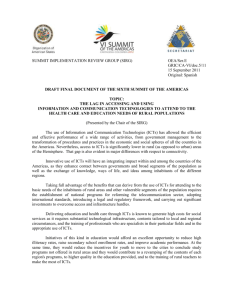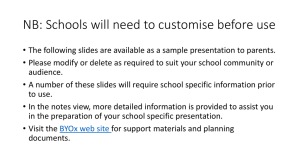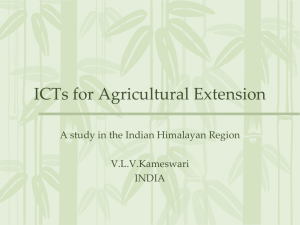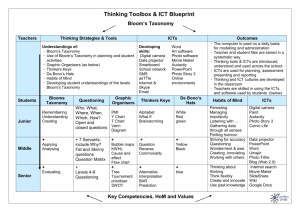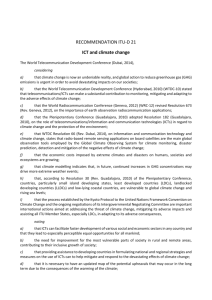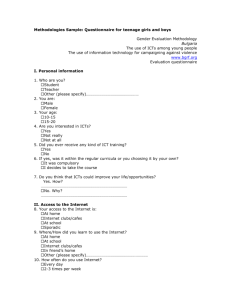A Some Thoughts on How ICTs Could Really Change the World
advertisement
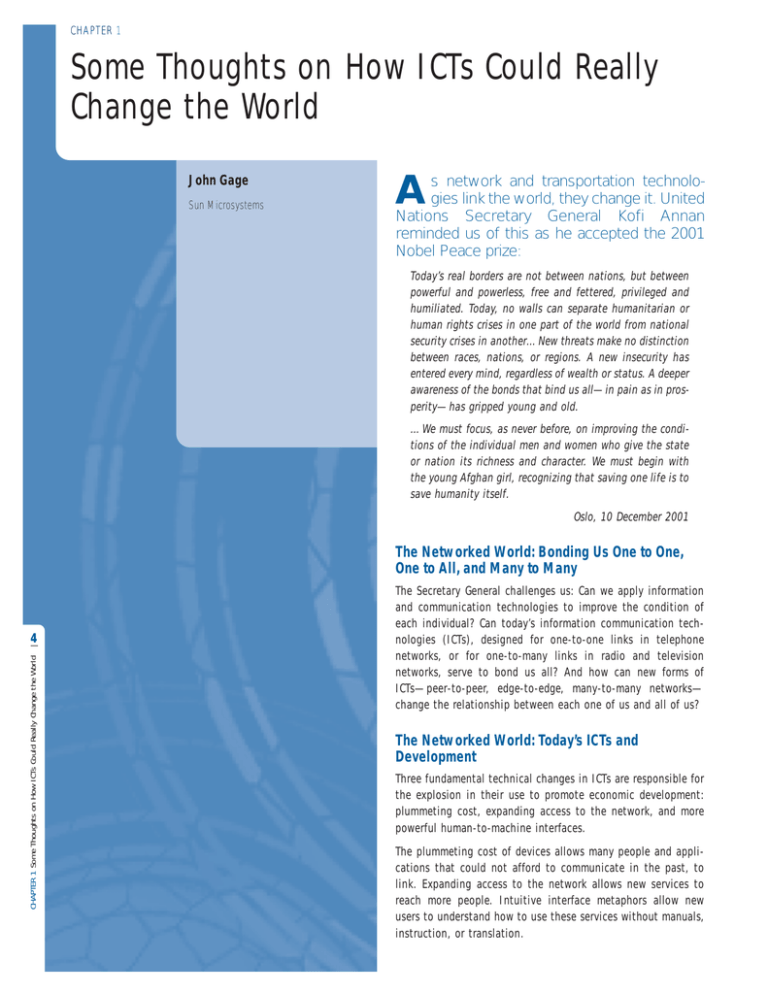
CHAPTER 1 Some Thoughts on How ICTs Could Really Change the World John Gage Sun Microsystems s network and transportation technologies link the world, they change it. United Nations Secretary General Kofi Annan reminded us of this as he accepted the 2001 Nobel Peace prize: A Today’s real borders are not between nations, but between powerful and powerless, free and fettered, privileged and humiliated. Today, no walls can separate humanitarian or human rights crises in one part of the world from national security crises in another…New threats make no distinction between races, nations, or regions. A new insecurity has entered every mind, regardless of wealth or status. A deeper awareness of the bonds that bind us all—in pain as in prosperity—has gripped young and old. …We must focus, as never before, on improving the conditions of the individual men and women who give the state or nation its richness and character. We must begin with the young Afghan girl, recognizing that saving one life is to save humanity itself. Oslo, 10 December 2001 The Networked World: Bonding Us One to One, One to All, and Many to Many CHAPTER 1 Some Thoughts on How ICTs Could Really Change the World 4 The Secretary General challenges us: Can we apply information and communication technologies to improve the condition of each individual? Can today’s information communication technologies (ICTs), designed for one-to-one links in telephone networks, or for one-to-many links in radio and television networks, serve to bond us all? And how can new forms of ICTs—peer-to-peer, edge-to-edge, many-to-many networks— change the relationship between each one of us and all of us? The Networked World: Today’s ICTs and Development Three fundamental technical changes in ICTs are responsible for the explosion in their use to promote economic development: plummeting cost, expanding access to the network, and more powerful human-to-machine interfaces. The plummeting cost of devices allows many people and applications that could not afford to communicate in the past, to link. Expanding access to the network allows new services to reach more people. Intuitive interface metaphors allow new users to understand how to use these services without manuals, instruction, or translation. But institutional change takes time. Governments and businesses are only now experimenting with ICT tools that have been available for twenty years. For technology to be used, we must match technology with need. We must carefully choose our focus. And we must measure what we are accomplishing. Remember the first law of technical change: Technology is easy. People are hard. The Networked World: Tomorrow’s ICTs and Development New technical capabilities are now emerging; their uses must be matched to needs. Four technical advances, in particular, promise to aid development—peer-to-peer (i.e., device-todevice) networks, precise local spatial data systems, sensor fusion, and unique identity systems—developments whose role in economic development demands new understanding and innovation. These advances are built from the innovations of the past, but provide new tools for change. First, peer-to-peer or device-to-device networks turn today’s networks on their head. Instead of centralized portals bringing data from big servers to users, the devices at the edges of the network share resources with each other, form self-organized groups, and migrate data and programs among themselves as needed. The aggregate of resources at the edge of the network is much greater than that of the resources in central servers, and the disparity will grow larger forever. This inevitable change means that today’s centers of information and resources become ever less important. A hundred million music lovers exchanging music files among themselves don’t ask permission from broadcasters or music publishers. container, truck, cell phone, well, fruit tree, plow, irrigation pump, unexploded munitions, street, or building allows more efficient use of existing infrastructure, and more efficient designs of new systems of transportation, water and power distribution, shipping, and early flood warning. For example, linking a sensor in an automobile air filter to the network, when coupled with meter-accurate Global Position Satellite (GPS) data, can give a precise guide to sources of chemical, biological, radioactive, or particulate pollution in a city. Linking the windshield wipers gives an instant, precise weather map—if they’re on, it’s raining. Third, sensor fusion—integration of devices that measure temperature, movement, pressure, acceleration, flow, electrical use, radioactivity, chemical composition—allows new forms of interaction between each device and its environment. For example, intelligent electrical motor control, aggregated across all air conditioners and refrigerators in a tropical city, can cut the peak load demand by 20 to 40 percent. Since electrical capacity is built for peak loads, significant investment can be saved through network-enabled efficiency. Fourth, unique identity systems—that is, systems that identify any device, program or user; that establish the authenticity of an identity; that authorize actions depending on permissions— provide the basis for transactions, whether commercial or societal. All contract systems, all payment systems are based on establishing and trusting the identity of the participants. New technologies, ranging from DNA analysis to face recognition to pressure-sensitive fingerprint recognition to unique signatures, make it possible to create new systems of personal trust. Examples are locks that open only for one person, gun triggers that can only be pulled by the finger of the owner of the gun, money transfers between devices whose mutual trust is established by a permanent, undeniable audit trail, or microcredit loans among individuals whose identities are known only by a trusted third party. New institutions—bank and nonbank—will arise to use these capabilities. How Will These New Capabilities Be Used? Furthermore, existing applications must be replaced in this new, distributed world. Application developers who create distributed, peer-to-peer applications from scratch, unburdened by the need to work on legacy centralized systems, have an advantage. An example of how rapidly a new, distributed technology can replace or supplant existing centralized systems is the explosion of cellular telephony in countries that abandoned exclusive control by expensive centralized telephone monopolies. By the end of 2005, more than two billion human beings will be linked by networked systems of mobile communications devices. Humans will talk. Humans will exchange messages. But something else will occur. The devices themselves will alter their own behavior by exchanging code with other devices on the network—machine-to-machine behavior modification. This is more than communication. This is a new foundation for systemic change. Innovation—creation of new applications or behavior—can be shared immediately with any authorized device on the network. The potential market for innovation is growing exponentially. Second, precise local spatial data embedded in every device and application creates new possibilities for engineering and market efficiencies. To know the location of every package, freight In the next five years the volume of machine-to-machine communications will surpass human-to-human communications. What will these machines be talking about? At first, just 5 CHAPTER 1 Some Thoughts on How ICTs Could Really Change the World These three changes will continue and accelerate. As a result, ICTs will permeate the poorest regions of the world over the next twenty years. Their use will provide new tools for economic development: to make markets more efficient, as discussed by Eggleston, Jensen, and Zeckhauser in Chapter 7 of this report; to change education, as discussed by Resnick and Hawkins in Chapters 3 and 4; and to change government and business institutional forms. the basics: who they are, where they are, how much power they’re using, how they might trust each other to form groups to do something more efficiently, how they might share secret data and programs, what their local sensors tell them about conditions and resources around them, and how they might cooperate to make more effective use of resources. In human terms: identity, trust, contracts, cooperation, and efficiencies. In development terms: bringing those with no voice today into tomorrow’s conversation. Today, a billion cellular telephones do some or all of these things. Soon, a billion new devices will join the conversation: credit cards, automobiles, shipping containers, power switches, motors, air conditioners, suitcases, light switches, envelopes, pacemakers, plows, water pumps, elevators—anything with electricity or an antenna. These emerging machine conversations provide us with new tools to redesign well-known human institutions: money, contracts, markets, auctions, knowledge exchanges, agricultural cooperatives, audits, currencies, taxes, human rights monitoring, traffic and freight management, health assessment and measurement, power management grids, water distribution systems. We will use them to build new systems of management, new tools for efficient resource allocation, new forms of governance and control. Our challenge is to design in the service of development. We can build new systems of credit—global mobile microcredit systems, for example—to create secure person-to-person transactions, bypassing today’s government-to-government, multilateral-togovernment, or business-to-business financial systems. We can create new forms of markets, new cooperatives, and new alliances. We can link sources of knowledge to those who need knowledge, nurse-to-patient, mother-to-mother. CHAPTER 1 Some Thoughts on How ICTs Could Really Change the World 6 The greatest challenge these new capabilities pose, however, is to balance control and freedom. Networked technologies of measurement, identity, location, and efficiency may enable a transformation of the economic system faced by the poor. The same technologies may also enable ubiquitous control. Remember the second law of technical change: Expect unexpected effects. The Networked World: Linking Creates Change Small changes in ICTs trigger unexpectedly explosive changes in use. The adoption of TCP/IP brought common networking, and suddenly all computers could communicate—the Internet was launched. The adoption of html, http and e-mail unified document exchange, and suddenly anyone could publish—enter the World Wide Web. Radio devices and spectrum became cheap, and suddenly anyone, anywhere could communicate—the wireless and cellular explosion had begun. The next explosions will come in the same way. Small changes in human-to-machine interfaces will trigger explosions in use. Here’s a partial list of what we can see today, and deploy globally in the next five years: • Speech recognition • Handwriting recognition • Gesture recognition • Face recognition • Emotion recognition • Identity recognition • Sensor fusion • Location recognition Clearly, each of these technical innovations has deep implications for human communication, and thus, for human development. In a world of six thousand languages and a thousand scripts, we are approaching the ability for any person to converse with any other person. To anticipate how these innovations will be used, we must use them ourselves. To form the empathetic bonds among ourselves that will make conversation meaningful, we must learn to see through another’s eyes. The Networked World: How We See Ourselves Let me give an example. Until this year, only a few groups of people, gathered in expensive rooms with expensive equipment—military command centers, intelligence agency situation rooms, satellite and space station control centers, advanced university research centers—could see through the eyes of satellite cameras looking down on earth. Few of them could merge satellite imagery with submeter high-resolution aerial survey pictures, and fewer still could merge this image data with exact Global Positioning Satellite data (street maps, building locations, vehicle location, ship and airplane positions). Today, a child—anywhere in the world, linked to the Internet— can reach across the network to access immense databases of images, bring them to the screen, and fly across the face of the earth, zooming down on streets and homes or up over mountain peaks and down river valleys. Today, a child can see planes on runways at San Francisco International Airport, visit the hospital inside the Imperial Palace in Tokyo, float above cars and trucks on the streets of Kabul, circle Mount Everest, or examine the bottom of the Grand Canyon. Real data, real pictures, real streets and buildings, real cars and trees and people. In the next few years, pictures at any level of resolution will enter databases in real time, gathered by network-linked cameras and sensors deployed by the millions, with meter-accurate location data as part of the picture. By 2005, over twenty countries and private organizations will have independent sources of submeter satellite imagery, enabling anyone to watch as teak trees are cut The power of this way of seeing the earth—continuous in detail from continents to cars, continuous through time— transforms understanding. The combination of ICT components, in a new way, makes a thousand-year-old dream accessible to a child: a magic carpet now exists to explore the earth and the way we see ourselves. Seeing from a distance becomes more powerful when joined with local data, data flowing up from the most decentralized sources, data never available before the arrival of ubiquitous access to the network. What may not be known or reported at a national level can be known and reported at a local level. Seeing the images of clear-cut logging in the center of the National Forest Preserve of Gabon takes on new meaning when local data is added that shows the names and companies of those doing the logging. Seeing deforestation in the uplands of Mozambique, Cambodia, or Liberia takes on new meaning when combined with local hydrologic data to show where the floods will go when the rains come. Local reporting combined with global information allows us to see ourselves as individuals, to see our neighborhood in relation to other neighborhoods. Global action coupled with local assessment is more effective action. Today, to understand human development, we rely upon aggregate data reported at a regional or national level. The statistical foundations of the United Nations Development Programme Human Development Report, the World Bank World Development Report, the United Nations Population Division reports—the fundamental guides we rely upon—are collected, estimated, and presented country by country. For lack of budget or for shortage of expertise or for political convenience, the data we rely upon for policy analysis and decision are aggregated, hiding local variation. But action to change individual lives is local, not general. Disaggregated data—from a school, a clinic, a police station, a well, a store—let us see what a person sees. Local information lets us understand in an immediate way what might be done to change that person’s life. This is one way to change the relationship between all of us and each one of us. Tomorrow, using new ICTs of location and communication, we will be able to see how many children die in a village, or the life expectancy for a mother in a neighborhood, or whether there is clean water or sanitation for a school, a village, or a street. We will see who lives and who dies. We will see ourselves in ways we cannot today. And for the first time, all of us will be able to see. Seeing what is shows us what to do. The Networked World: From Readiness to Global Information Technology Report Two years ago, with the publication of Readiness for the Networked World: A Guide for Developing Countries by the Center for International Development at Harvard University,1 a conversation intensified among policy, business, and technology communities about the use of information and communication technologies in the service of human development. The remarkable expansion of the Internet since the early 1990s convinced millions that the vision of ubiquitous access by business and citizen to global stores of knowledge at ever-decreasing cost would soon be realized. The report sought to establish tools to determine just where the world was along the path to global interconnection. To do this, the Guide provided a framework for diagnosis and evaluation of the level of information technology present in a community. This framework created a point of view; in each category—learning, economy, society, policy, access—measurement suggested action. Higher levels of readiness meant more bandwidth, more transparency, more standardized commercial instruments, more independent regulation, more competition, and more communication devices. The focus was upon the components of the Networked World. This report, the Global Information Technology Report, focuses not on components, but on the interaction among systems of components. It focuses on the emerging patterns of use of information and communications technologies (ICTs) to create bonds—economic bonds, social bonds, generational bonds, educational bonds, cultural bonds—bonds in the large and in the small. Access by all to ICTs enables new bonds to form among individuals, communities, villages, regions, families and institutions; these emerging bonds are the substance of how ICTs affect development. 7 The emergent structure of this report reflects what we have learned, and what we need to learn, about the interaction of ICT systems with existing human systems of communication, commerce, health, education, and governance. But we need to disaggregate our focus, to move closer in our data and our understanding to the individual, the family, the young girl in Afghanistan. Today, our studies are at a national or city level. Tomorrow, they must be at the most local level, to enable us to understand emerging patterns of use. The most powerful consequence of global access to ICTs is to enable this understanding. The distinction between systems and components in this report is critical. In technology, individual devices develop along a predictable trajectory. Systems of devices do not. Unpredictable interactions among systems create unexpected results, described and studied today as “emergent” or self-organizing behavior, following the language of biology. And ICTs, in the CHAPTER 1 Some Thoughts on How ICTs Could Really Change the World down in Burma and floated across the Salween River to Thailand or watch freighters cross the Arabian Gulf to any destination. first decade of this century, are reaching a global threshold of scale and complexity, leading to new, emergent interactions and new uses. Understanding this emerging global interaction of individual components is the foundation for change. The Networked World: Complex Systems Built from Simple Components Predicting what complex systems will do is hard. It’s easy to understand what a simple machine will do—a wheel, a lever, a piston, a gear, a switch—but when they combine to become a system—a cart, a train, an automobile, a computer—simple machines interact in new ways. New systems emerge: the cart system changes the street system; automobile systems change streets, buildings, traffic control systems, court systems, training systems, energy systems, agricultural and urban systems, courtship and marriage systems. As previously independent complex systems link, new systems emerge, often with unanticipated uses and behavior. We assume that technologies have a certain scope. Automobiles transform systems involving transport of material goods. Electrical and oil technologies transform systems involving energy. Chemical and materials technologies transform systems of atoms. Information technologies transform systems involving transactions, ideas, perceptions, memory, and control. Today’s ICTs have become involved in all these systems, and therefore offer new ways of transforming them all. CHAPTER 1 Some Thoughts on How ICTs Could Really Change the World 8 In the past thirty years of ICTs, we have built the Internet, an artificial construction that is approaching the complexity of cities or of biological systems. To predict how this most complex of human creations might change human economic, societal, and cultural systems usually leads us to focus on the individual components: the computers, the telephone wires and instruments, the radio spectrum, the wireless hand-set, the television; we count them, predict their declining cost, measure their penetration, forecast their message volume as they assist existing human uses of exchanging market information or sharing family news. We study technology, not systems. Biologists, in analyzing life, emphasize the transmission of information in reproduction. Even a virus or prion, incapable of using energy to alter its surroundings, finds a way to reproduce information about itself, and thereby reproduce itself. Today’s most advanced biological technologies are based on better understanding this transmission of information. In human societies, we create educational systems to enable cultural transmission, but ICTs are changing the fundamental assumptions of cost and availability of information. New means of linking and transmitting human understanding are emerging as we begin to understand the new tools. As Mitchel Resnick points out in this collection of essays, we must learn how to reform educational reform to match the complex systems that have arisen through ICTs. The Networked World: Where Are We Going? How are we responding today to the Secretary General’s challenge? Have ICTs been used to eradicate poverty, prevent conflict, and promote freedom? The evidence is certainly against us, so far. As we invented and deployed communication technologies—telegraph, telephone, radio, television—the tools of ubiquitous one-to-one and mass communication—we created the deadliest century in human history. We developed the technical means to share with every human the most advanced knowledge in health and food production, the provision of clean water, healthy housing, and economic development. But these same technical means of communication enabled global warfare, international crime, and mass mobilization of hatred and prejudice. Today, they enable pinpoint targeting of conventional bombs, deployment of weapons of mass destruction, destruction of personal privacy, and ubiquitous surveillance. This is not new. Powerful technologies will be used by the powerful to maintain and extend power. Access to knowledge does not mean it will be used to transform cultures and societies, or empower the powerless. What is different today? We are crossing a threshold of access. What has been available only to the rich, only to the powerful, is becoming available to a majority of humans, human groups, and human organizations. The rhythm of change is accelerating. The capability to build new institutions that bond us all is arriving. We must seize the opportunity to create them. It is technically possible today to enable a hundred million people living in rich countries to make person-to-person loans of US$100 each to a hundred million people living on a dollar a day. It is technically possible for tens of millions of migratory workers to remit their earnings to their distant families at almost no cost. But it cannot be guaranteed that these networked person-to-person money transfer institutions will not be used to finance the world drug trade or terrorist cells. Still, we must try. In choosing to create institutions where technical change has the greatest impact on individuals, the creation of direct person-to-person financial links heads the list, followed closely by direct family links—exchanges as simple as sending baby pictures to a grandmother, or joining family members separated by war or migration. The Networked World: What Should We Do Now? their school and technology—what they study, what use they make of the Internet, what they dream of doing. Every week, the newspaper prints one of these stories in the paper, and puts all the other stories on the newspaper website. At the end of the year, fifty-two students have been in the paper; thousands of others have written for Web publication. All of them have possible new careers; all of them have helped the rest of the country, and the rest of the world, understand what their lives are like. Until now, it has been too expensive and too difficult for all of us to have a conversation. No longer. Today, anyone can tell the world about his or her local community. Here are three immediate, measurable actions that can make this global conversation real. • Link the schools, cafés, churches, mosques, clinics, community centers—any place people gather in a community—to the Internet. As a core component of a national economic development policy, governments should provide free network connectivity to schools. Why schools? Because schools touch every family, every parent, every child, and every neighborhood; schools are a focal point everyone understands. • Draw upon the employees of every telecommunications company, every computer company, every ICT company, every government, and every ministry of telecommunications and ministry of education in every country to design and implement network connectivity for their own children’s schools. Each company or ministry should match the contribution of time by its employees with a contribution of equipment, money, or training. For every such school connected, they should adopt and connect a poor or rural school. • Use the examples of existing programs as templates for school connectivity, curriculum creation, and teacher training. World Links, Schools OnLine, NetDay, Educar.org, Cisco Network Academies, Canada SchoolNet, ThinkQuest, and many others provide real examples in dozens of countries. • Use local spatial data to create a map with a dot showing the location of every school, and color-code the school’s dot to show if it is connected to the Internet. Do the same for health clinics, universities, cafés, neighborhood centers. Create competition to be connected. The map is the measurement of change. • Create personal bonds among children in schools worldwide. Remember, every child in the world has an e-mail account today waiting for him or her, with Yahoo or Hotmail—all they need is access. • Build networks of local information at the most decentralized level possible; ask local small businesses, farmers, merchants, teachers, and parents to share local news. Supplement today’s systems of gathering statistics and assessment. Post local market prices. Support local auctions. Create local genealogies. Third, form a local microcredit organization at the linked location. • Use identity systems from local banks or telecommunication providers, or use international systems to allow every person in a dollar-a-day community to have an account, an identity. Transfer money into that account. See what institutional forms develop. • Link poor people to a sponsor in a rich country. Form person-to-person bonds between the lender and the recipient. Call upon large organizations to create each-one-reach-one links to those whose names they can now know. • Maintain frequent contact. Measure it—by organization, by individual. Reward it. How Do We Measure Our Progress? Our goal is to improve the conditions of every individual. Our focus is to choose technologies that bind. Our task is to create institutions that bond us all. Our test is to show that at the end of each project we undertake, each reform we implement, each report we write, each conference we hold, a new bond is created between individuals, a new link that did not exist before. If we meet that test, we respond to the challenge of Kofi Annan: We must focus, as never before, on improving the conditions of the individual men and women who give the state or nation its richness and character. We must begin with the young Afghan girl, recognizing that saving one life is to save humanity itself. Second, ask each linked location to describe their local world. • See through the eyes of children. Form a partnership between a major newspaper, magazine, or radio or television station and the local schools. In each country, each national newspaper with a website should initiate a nationwide project to see the country through the eyes of the children. Teachers in each school—elementary, middle, and secondary—select one or two students as the School Technology Reporters. Every week they write a story about Endnote 1 Information Technologies Group. Readiness for the Networked World: A Guide for Developing Countries. Cambridge, Mass: Center for International Development at Harvard University, 2000. 9 CHAPTER 1 Some Thoughts on How ICTs Could Really Change the World First, complete the job of ubiquitous connectivity and access.
